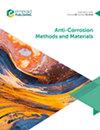大跨度悬索桥吊杆环境腐蚀等效换算研究
IF 2.6
4区 材料科学
Q2 METALLURGY & METALLURGICAL ENGINEERING
引用次数: 0
摘要
目的研究多因素作用下大跨度悬索桥吊杆加速腐蚀试验与真实环境谱的等效关系。基于法拉第定律,以腐蚀电流作为金属腐蚀的度量,建立实验室环境与实际使用环境的等效转换关系。确定了不同温度、湿度、pH值和NaCl浓度条件下桥梁结构钢的等效转换方法。提出了考虑多因素的大跨度桥梁环境谱编制方法和等效转换原理。温度、湿度、pH值和NaCl浓度等环境因素对悬索线腐蚀程度有显著影响,仅考虑这两个因素进行等效换算不能准确反映桥梁的真实使用环境。在标准条件下进行的33.8 h盐雾加速腐蚀试验相当于吊杆在实际使用环境中一年的腐蚀。本研究提出的钢丝绳等效加速腐蚀法能够有效预测吊杆的腐蚀程度,并经验证是正确的,可为制定钢丝绳腐蚀试验方案提供理论指导,为悬索桥吊杆的防腐控制和日历寿命研究提供工程技术依据。本文章由计算机程序翻译,如有差异,请以英文原文为准。
Equivalent conversion investigation of environmental corrosion of suspenders in long-span suspension bridge
Purpose This paper aims to investigate the equivalent relationship between accelerated corrosion tests and real environmental spectrum of suspenders in long-span suspension bridge considering multiple factors action. Design/methodology/approach Based on Faraday's law, corrosion current was used as a measure of metal corrosion, and the equivalent conversion relationship between laboratory environment and real service environment was established. The equivalent conversion method for bridge structural steel had been determined under different temperature, humidity, pH value and NaCl concentration conditions. The compilation of environmental spectra for large span bridges considering multiple factors and the principle of equivalent conversion have been proposed. Findings Environmental factors, including temperature, humidity, pH value and NaCl concentration, have significant impact on the corrosion degree of suspension steel wires, and only considering these two factors for equivalent conversion cannot accurately reflect the true service environment of the bridge. The 33.8-h salt spray accelerated corrosion test using the standard conditions can be equivalent to one year of suspenders corrosion in a real service environment. Originality/value The equivalent accelerated corrosion method for steel wires proposed in this study can effectively predict the corrosion degree of the suspenders, which has been verified to be correct and can provide theoretical guidance for the development of corrosion test plans for steel wires and engineering technical basis for anti-corrosion control and calendar life research of suspension bridge suspenders.
求助全文
通过发布文献求助,成功后即可免费获取论文全文。
去求助
来源期刊

Anti-corrosion Methods and Materials
工程技术-冶金工程
CiteScore
2.80
自引率
16.70%
发文量
61
审稿时长
13.5 months
期刊介绍:
Anti-Corrosion Methods and Materials publishes a broad coverage of the materials and techniques employed in corrosion prevention. Coverage is essentially of a practical nature and designed to be of material benefit to those working in the field. Proven applications are covered together with company news and new product information. Anti-Corrosion Methods and Materials now also includes research articles that reflect the most interesting and strategically important research and development activities from around the world.
Every year, industry pays a massive and rising cost for its corrosion problems. Research and development into new materials, processes and initiatives to combat this loss is increasing, and new findings are constantly coming to light which can help to beat corrosion problems throughout industry. This journal uniquely focuses on these exciting developments to make essential reading for anyone aiming to regain profits lost through corrosion difficulties.
• New methods, materials and software
• New developments in research and industry
• Stainless steels
• Protection of structural steelwork
• Industry update, conference news, dates and events
• Environmental issues
• Health & safety, including EC regulations
• Corrosion monitoring and plant health assessment
• The latest equipment and processes
• Corrosion cost and corrosion risk management.
 求助内容:
求助内容: 应助结果提醒方式:
应助结果提醒方式:


